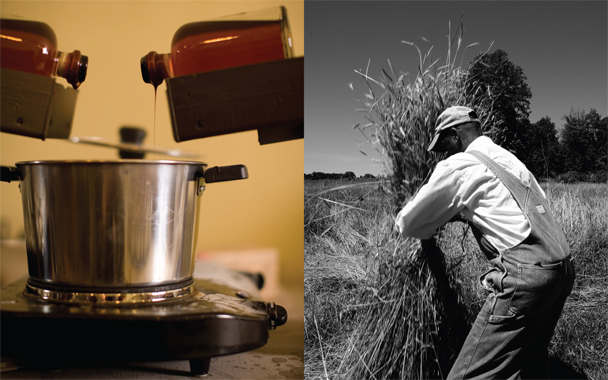It was the morning after July 4, and roughly 30 New York City bartenders boarded a party bus—complete with booming sound system, neon lights, and a stripper pole—for a booze-and-doughnut-fueled excursion from Midtown Manhattan to boutique distiller Tuthilltown Spirits, two hours north in the fertile Hudson Valley. Hedonistic road trip aside, these bartenders take their craft seriously, and they were ready to geek out about distilling, enjoy a tasting, and (to my interest) harvest some rye.
Taking their turns in the five-acre field of ripe grain, each barkeep spent several minutes using a sharp sickle to whack handfuls of bristly stalks that would be made into an upcoming batch of the company’s Hudson Manhattan Rye Whiskey (a popular choice among this crowd). Once they had cut enough stalks to form several large bundles, they hauled the fruits of their labor to a holding pen, from which the rye would go through the process of becoming rye whiskey.
Since fresh fruit, classic cocktails, and proper ice cubes have become de rigueur in high-end bars, harvesting crops for spirits doesn’t seem like such a stretch. Just as chefs have become increasingly intimate with their ingredients (to the point where they may even grow their own), are we moving toward a time when top bartenders will be involved in selecting the grains for their whiskey, rum, or gin?
“We have seen this golden movement of the cocktail, and [bartenders] are thinking like chefs,” says drinks consultant Brian Van Flandern, who co-led the tour. “One of the newer trends in the culinary world is to source your ingredients and tell the stories behind them. And bartenders are doing the same thing. They are trying to find the stories behind the drinks they serve.”
Van Flandern, the one-time bartender at Per Se, has harvested grapes for Sherry in Jerez, Spain, and for Cognac in the southwest of France. With the aid of a jimador in Guadalajara, he spent part of a vacation shearing prickly leaves from an agave plant with a machete before using a coa de jima, a sharp paddle, to uproot the piña. Learning the hard way, he lifted the base to “see how heavy it was,” not realizing that raw agave is highly acidic. The painful result: “I had blisters all up and down my arm.”
“You go the fields and see jimadors shaving the agave and you see that it is backbreaking work,” he says. “It helps dispel the myths Americans have about tequila” (which is often associated with collegiate drinking binges that most people would rather forget).
Meaghan Dorman, of the Raines Law Room, has also harvested sugar cane at the Zacapa Rum distillery, in Guatemala. After learning firsthand why Zacapa is a little sweeter than other rums, she uses it for her take on an Old Fashioned (which is half rum and half cognac) and the Islay Daiquiri (1.5 ounces Zacapa, 1/2 ounce Ardbeg Scotch, 1 ounce lime juice, and 3/4 ounce simple syrup, shaken over ice and served straight up). “We are always looking to balance the sweetness. Along with the lime and the smoke from the Scotch, it gives [the daiquiri] another dimension,” adding layers of sweet and tart.
It wasn’t quite as serious at Tuthilltown. Local historian Peter Curtis was on hand to give the bartenders a tutorial (“Cut low. You have to cut low.”), and then a gentle scolding when their work was not up to snuff (“You’re cutting too short!).
But it was a learning experience nonetheless for Dorman: “It’s very hard to visualize or imagine the process of creating liquid alcohol from actual rye in the field until you see it up close.”
It’s why distillers like Marko Karakasevic of Charbay Winery & Distillery in Napa Valley often invite bartenders and sommeliers to help harvest the raw ingredients and process its wines, vodkas, and rums. And why Restaurant Eve and PX Lounge mixologist Todd Thrasher joined Cirrus vodka distiller Paul McCann to dig for Virginia Russet potatoes at a local spud farm. “There are so many different potatoes that are used to make vodka,” Thrasher says. “To taste it before it is distilled, it helps with mixing.”
Chicago mixologist Adam Seger, of Nacional 27, has made farming part of his job duties. He has picked Pinot Noir grapes in Burgundy for wine and Albariño in Rias Baixas for Orujo, a grappa-like spirit made from the grape skins and seeds left over from wine production.
Recently, Seger teamed up with the organic Wisconsin farm Harvest Moon to tend his own plot, where he is growing heirloom tomatoes and ground cherries for use in cocktails including an heirloom-tomato Mojito.
“It definitely gives you a much, much deeper appreciation what goes in the glass, whether it’s what is going in the spirit bottle or what you are adding to the cocktail,” Seger says. “I generally look at food trends for what’s going to happen in cocktail trends. Mixology is getting so close to the food world—it’s farm-to-bar or farm-to-glass.”



 Pinterest
Pinterest


